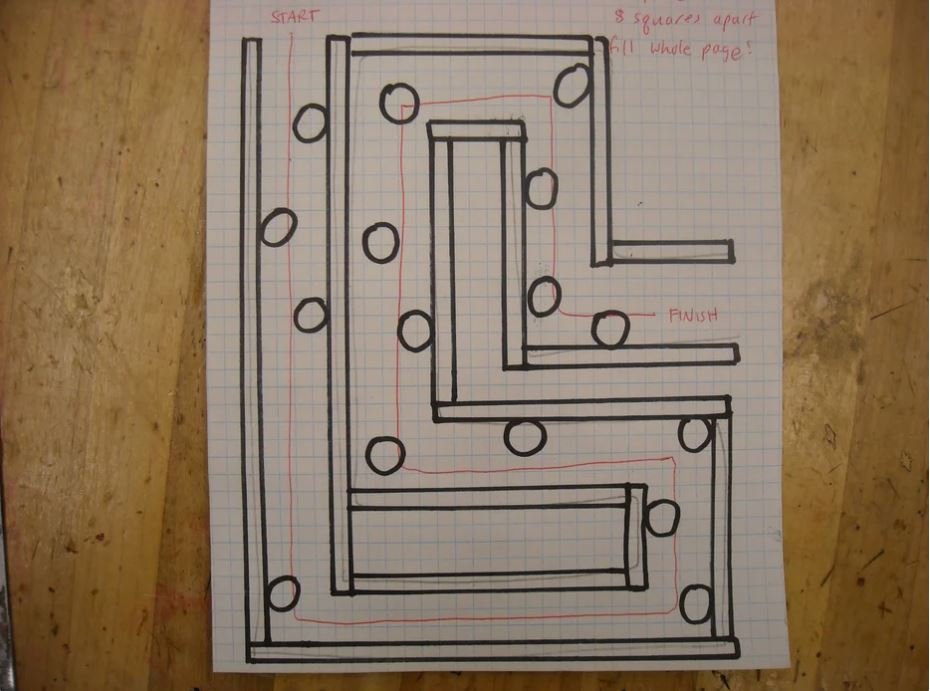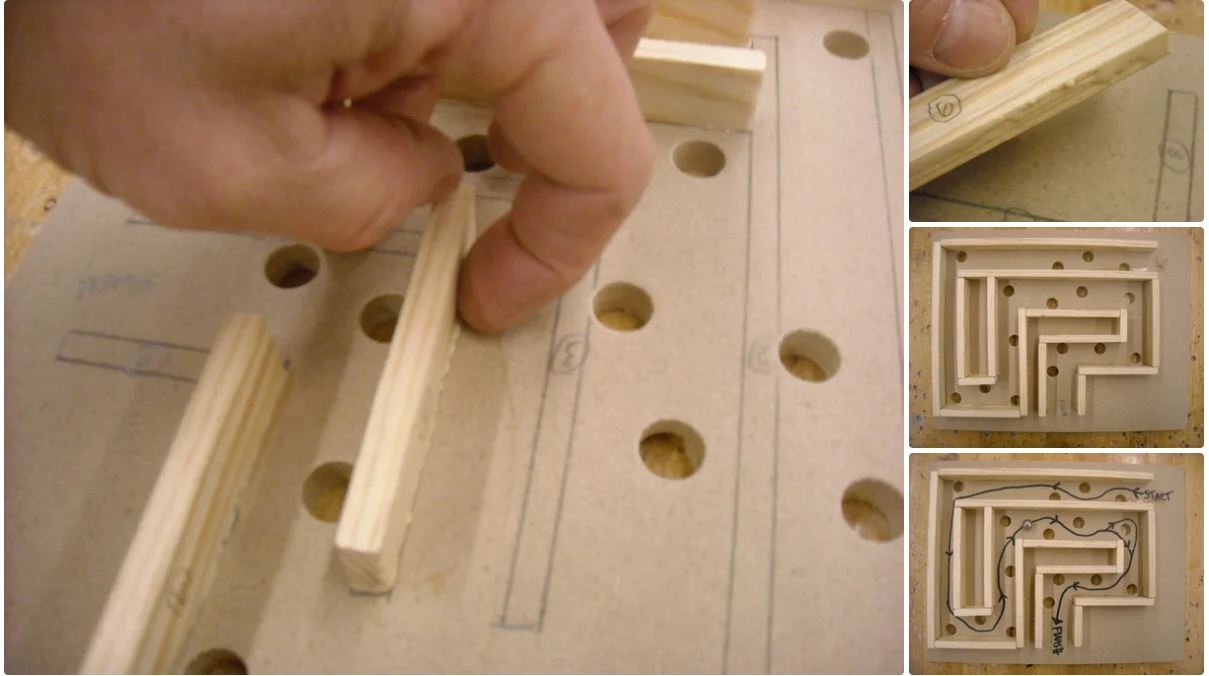A Labyrinth Kids Can Make

Note: All projects performed following instructions found on this site are done at your own risk. Learn more
I've been building this labyrinth with my grade 6 woodwork kids for the last 4 years with great success.
What i needed was a project the kids could build that would include creative design, measuring, using a scroll saw and a drill press.
I stumbled on the traditional labyrinth that we all used when we were kids... remember the one that was in a box with 2 knobs that were really hard to use?
The kids also had I-phone versions they played and I thought "why not one that's REAL?"
When kids in grade 6 walk into the woodshop for the first time they have already heard about the project from their siblings and are SO excited to get started.
So here are my learning objectives:
- The students will learn to creatively solve a problem within a set of guidelines.
- The students will learn to measure, apply the measurements and create a cutlist
- The students will learn to safely use a drill press and a scroll saw.
- The students will learn to effectively learn to glue.
Materials:
- 1/4" square graph paper.
- carbon paper
- 3/8" MDF 8.5" by 11"
- 1/4" wood strips 3/4" by about 3'
- Glue
- Masking tape
- 7/16" steel ball bearing. You can get these from electric motor rebuild places or just look under bearings in the 'pages.
Tools:
- Pencil, ruler
- 12" Forstner bit
- Scroll saw
- Sanding board. (or just plain 120G paper sheets)
Note: As an Amazon Associate, I earn from qualifying purchases.
Step 1: Starting the Design

I start by asking the kids what a labyrinth is. I usually end up reminding them about the garden maze or talking about the one that we've all seen with the 2 knobs.
I go to the board and start drawing a big rectangle than ask for where a start and finish should be.
Than I ask the kids to describe paths from start to finish... the catch is the line can't touch or cross.
Often i'll get kids to come up and draw paths as well. Eventually i guide them to a design thats interesting but not too twisty.
They all say "thats TOO EASY!!" so I ask them to make it tricky by adding holes... They quickly figure out that holes placed in the right spots.... at the end of long runs or on the outside of a curve or in a way that makes the ball have to curve back and forth... make it tricky.
Than I ask HOW we're going to make sure the ball follows the path... The kids figure out that walls will control the ball.
I set them all up with pages and say that i want 4 different paths with walls and holes all quick sketched in 20 minutes.
They freak out and ask for more time. I say "NO WAY!" and yell GO!!! They love that its kind of a race...
This gets their brains going.
At the end of the 20 minutes (or whatever they need... i fudge it...) i say to stop and give them rules... i write them on the board...
Choose 1 and use the graph paper to draw it.
- All up/down and left /right. No angles. (tough to build)
- The ball takes up a space of 4 squares. So do the holes. This means that they must allow space for the ball to roll around the holes.
- The walls take up 1 square wide. The kids have to allow room for the walls.
- You have to allow at least 3 squares wide in between walls.
I than get the kids to start a rough but accurate drawing of the path.
They than add the walls roughly. check out the pictures...
Step 2: Adding Details

I get the kids to start thinking about real sizes by adding the walls with a ruler. They have to stay on the graph paper lines and maintain a wall thickness of 1 square.
By now they start drawing in holes which is good because its the next step... I draw the holes as being 2by2 squares...4 total.
They start to sketch in the holes which usually brings up problems such as "How will the ball fit by?"
Usually they will need to combine walls that are next to each other into 1 wall or even start over. I won't let them rip up or throw away pages because its all part of the process.
Once they are happy with their drawing They bring it to me and i look for areas that might be a problem.
If they need to make changes now is a good time! If the drawing is ready I sign it somewhere inconspicuous. (for marking later)
Step 3: Transfer the Design

I demonstrate using the graph paper by having a labyrinth design of my own. I tape it to the MDF than put a piece of carbon paper under it.
Use the ruler and pencil to draw in all of the drill holes. Than i usually get a sharp piece of wood and use it to (invisibly) draw a big smiley face.
I ask the kids if they wan to see whats under the page so i lift it and they see the big smiley face. They LOVE it. Easily impressed i tell you.
Than i start drawing all the walls that are vertical... checking once in a while to check progress. Once i get all the vertical lines done i do all the horizontal lines.
Once the drawing is done i pull off the paper and remind them to NOT throw away the design. It is worth 10% of their grade. This motivates some kids to keep work...
Step 4: Start Measuring the Walls

In this project i just wanted the kids to learn to make scaled comparison... not actual ruler measuring.
It would be really easy however to incorporate this... most likely using the graph paper as a way of showing fractions.. each square is 1/4" than working up to full inches.
Because it is only 1/4" scale you don't have to worry about smaller fractions which is a step more in measuring.
You could get the kids to count squares than convert to whole numbers to show the size of wood they need to cut. Come to think of it i think i will do this next rotation of kids. 🙂
In the photos it shows what i do now which is to lay the wood next to the MDF than mark all the wood piece sizes.
Make sure they label all the pieces! I had a kid last rotation who had 42 pieces. Turned out well thankfully!
I use 1/4" cheap plywood i had around.. Cut it out with a tablesaw into 3/4" strips. If you have the materials and want to get fancy use some solid wood. Gets expensive though.
Step 5: Cutting the Walls

I have the younger kids use a scroll saw to cut the pieces of wood.
I also teach them to use the handsaws if they are a group that will have a hard time with power tools... Bigger kids can use the bandsaw which is more accurate for straight lines... After cutting they can use the sanding board to get rid of any wood fuzzies and square up the edges.
I like to introduce this step the class before the drill demo which takes less time... This gives the kids lots of jobs to do... measuring, cutting and drilling next day.
I find that if i do all of the demos in one day smoke starts coming out of their ears...
Step 6: Drilling the Holes

The day after you demo the wood cutting do the drill demo. I use a 1/2" forstner bit.
Set the depth so that at full extension the point of the drill bit just goes into your waste board. When you show the kids make sure you use a C-clamp.
Have them work in pairs... with one kid in control of moving the board and one kid loosening and tightening the C-clamp.
Drill all the holes but point out that the drill won't go all the way through... next step... keep the suspense...
Once the holes are drilled flip the board and show the kids how just the tiny tip has gone through... put the board down, carefully line up the tip of the drill with the pinholes showing through and drill.
This is the cleanest way to drill through MDF with a drill bit. The kids really like poking out all of the little disks that are left in the holes...
As a side note for demos... I have REALLY big classes... 30 kids... what I do is get all of the kids with short stools to sit around the machine, short kids standing behind (I'm a short guy so i make a joke or two about it...) and tall kids standing at the back.
This arrangement usually works. I make sure kids are not hiding and tuning out of the demo. I usually get at least one huge kid standing right in front... i suggest that maybe he/she is not such a good window...
Last step for the holes is to rip a small square of sandpaper and smooth the holes. After drilling, a small lip usually develops which stops the ball from rolling in..
Step 7: Gluing and Finishing

Once the drilling and cutting and sanding is done the kids can start gluing. Make sure they spread just a little on with their finger... too much makes a huge mess of glue which needs to be wiped off.
Glue-out at the edges will stop the ball from rolling smoothly. I usually apply glue in batches of 5 or 6 pieces, attach them into place than move to another batch.
Most wood glues dry fast so the kids won't have to wait long!
Use a piece of wood to remove any squeeze-out.
Draw a path for the ball to follow.
Give out 7/16" balls. This sounds a bit... controlling... but i note on a list who got bearings because the kids lose them really really fast than come back for more. I've had classes go through 60 balls.
